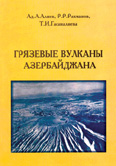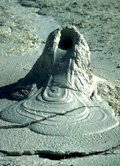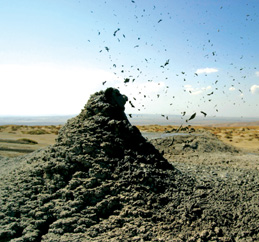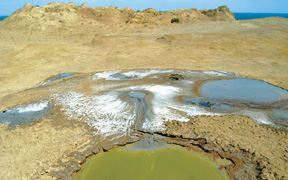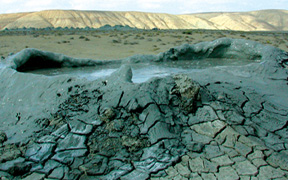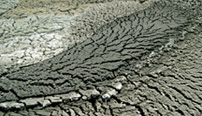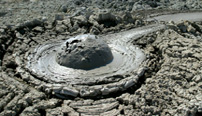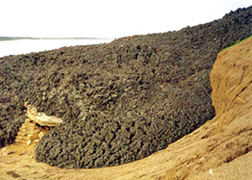|

Volume 15.1
Pages
38-45
Mud Volcanoes
Questions
& Answers
This
article in Question & Answer format was based on information
provided by the following specialists:
Ronnie Gallagher, James
Skinner, Hartmut Mueller, Seid Huseinov.
PHOTOS Hartmut Mueller, Adil
Aliyev, Ronnie Gallagher, Oleg Litvin.
What are
mud volcanoes?
Mud volcanoes are essentially channels for releasing pressurized
gas and mineral water. They sometimes contain traces of oil,
together with associated mud from great depths within the earth
(often as deep as 8-12km). Essentially mud volcanoes are open
pressure valves in the earth's crust. They are often created
at points of weakness in the Earth's crust, along fault lines.
Above left:
"Mud Volcanoes of Azerbaijan,"
by Dr. Adil Aliyev, R. R. Rahmanov
and T. I. Hasanaliyev. In Russian.
Above middle:
"All about Mud Volcanoes,"
by Azerbaijani scientists I.S. Guliyev and A. A. Feizullayev.
This book,
published in English, was sponsored by BP. Nafta Press: 1997.
Above right: Small mud volcano eruption.
What is the
relationship between mud volcanoes and oil?
Mud volcanoes associated with hydrocarbons resemble super-deep
exploration wells in the sense that they can be direct indicators
of petroleum deposits at great depths and provide valuable information
on the formation and migration of oil and gas. Both mud volcanoes
and hydrocarbon fields are the result of a single process of
oil and gas formation, which has a characteristic vertical zone
with methane gas forming in the younger strata, overlying a zone
of intense formation of oil and gases.
How are mud volcanoes similar
to lava volcanoes?
Mud volcanoes and lava volcanoes are considered to be close cousins.
Both can be enormously powerful. Both seem to be unpredictable
in terms of when they will erupt. Both can hurl out flames and
billows of smoke to great heights, sometimes several hundred
meters. Both can spew out millions of cubic meters of clay from
the bowels of the earth. Both can create islands if they erupt
from the floor of the sea.
Above left: Nature Photographer Hartmut Mueller,
on assignment with the Ecology Ministry in
Azerbaijan, captures a rare moment when a mud volcano is spurting
mud. Mueller, who has an
entire series of photos about mud volcanoes, says this is, indeed,
a rare sight.
Above
right: Mud flow at Dashgil.
Photo by Dr. Adil Aliyev.
Well then, how are mud volcanoes
different from lava volcanoes?
They're quite different in terms of temperature. Lava volcanoes
originate from molten rock or magma, which generate enormously
high temperatures as fires escape from their cones during eruptions.
Mud volcanoes result from an increase in pressure underground
and the release of fluids in mud and associated gases. They are
not necessarily hot, though they may be. In fact, material spewed
out from mud volcanoes can be quite cool, sometimes even close
to freezing temperatures.
How many mud volcanoes exist
in the world?
It all depends on how you define mud volcanoes. Do you call a
little cone, no higher than a foot or so, a volcano if mud happens
to ooze from it? If so, then there are hundreds of thousands
of them scattered throughout the world. However, scientists generally
refer to about 700 mud volcanoes around the world.
Above
left: The latest major mud
volcano eruption at Lokbatan near Baku took place on October
10, 2001. However, volcanoes at this location may have been erupting
for centuries. Geologists working
for the Nobel Brothers described such an occasion that took place
there in 1887. Photo by Dr. Adil Aliyev.
More info: search at AZER.com.
Above right:
Mud volcanoes emit muds
of varying colors and consistencies, including oil. Photo by Hartmut Mueller.
Where are mud volcanoes primarily
found?
They can be found all over the world. The greatest concentration
of them is found in Azerbaijan, Turkmenistan, and the South Caspian
region. Specifically, more than half of the world's mud volcanoes
are said to be located in Azerbaijan.
Mud volcanoes have also been found in Australia, Taiwan, Trinidad,
China, Myanmar, Iran and Pakistan.
Only a few exist in Europe: the Kerch Peninsula in southeastern
Ukraine between the Black and Azov Seas, the Apennines mountains
in southern Italy and Sicily, and the Carpathian mountains near
Berca, Romania.
How many mud volcanoes exist
in Azerbaijan?
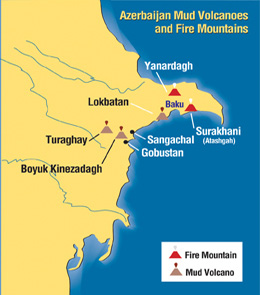  Again,
the number would vary according to one's definition of the term,
but several hundred sizeable mud volcanoes have been identified
by geologists in Azerbaijan. Again,
the number would vary according to one's definition of the term,
but several hundred sizeable mud volcanoes have been identified
by geologists in Azerbaijan.
Why are there so many mud
volcanoes located in Azerbaijan?
Mud volcanoes are associated with oil and gas prospects often
within hydrocarbon source rocks. Hydrocarbon deposits are estimated
to be very high in Azerbaijan, especially in the lower geological
sections of the middle Pliocene, Paleogene-Miocene and Mesozoic
layers.
Do mud volcanoes occur only
on land?
No, like their igneous cousins, mud volcanoes can also be found
on the floor of the sea.
How large can mud volcanoes
be?
Mud volcanoes differ greatly in size. Usually, their height does
not exceed more than 1-2 meters although some mud volcano mounds
grow to around 500-700m high. In width, they can range from a
few centimeters to a few kilometers.
Left:
Map of general locations
of mud volcanoes and fire mountains on the Absheron Peninsula
and to the south of Baku along the Caspian coastline. Azerbaijan
seems to have been aptly named "Land of Fire." Azerbaijan
has an estimated 200-300 mud volcanoes of varying sizes.
What are the largest mud volcanoes in Azerbaijan?
The largest mud volcanic mounds in Azerbaijan are like mountains.
Two of them are gigantic: Kinezadagh (397m high) and Turaghay
(400m high). Both are located southwest of Baku along the coastal
region of the Caspian. See Mud Volcano and Fire Mountain Map
on page 40.
 |
 |
Above left: Kinezadagh, second largest mud volcano
in Azerbaijan (397m high).
Photo by Ronnie
Gallagher.
Above right: Eruption at Kechaldagh. Photo by Phil Hardy.
When Turaghay erupted in 1947, it emitted some 50,000 cubic meters
of breccia / mud. Even if such a large quantity of mud were typical
of an average eruption, the formation of a mountain this size
would have required approximately 6,000 eruptions. Since mud
volcanoes are comprised of soft and fluid mud, they are considered
to be rather ephemeral on a geological timescale because they
are prone to erosion. With wind and rain, the mud quickly erodes
into systems of gulleys and ridges fanning out from the crater
margins. Indeed, the tell-tale sign of a mud volcano is its deeply
grooved and flanks sides which often are very attractive.
Above left:
Mud volcanoes at Shirvan.
Photo by Dr. Adil Aliyev.
Above right:
Close up of small mud volcano
at Dashgil. Photo by Dr. Adil Aliyev.
Are there different kinds of mud volcanoes?
Like an igneous volcano, the mud can be fluid and flow easily,
or it can be thick and sticky. The first kind tends to erupt
continuously in a bubbling manner, while the second type tends
to be explosive and produce spectacular fireballs when it erupts
(like Lokbatan).
How old are mud volcanoes?
In the scheme of geological processes that spans millions of
years, mud volcanoes are viewed as being fairly recent. It's
hard to determine how old a specific mud volcano might be. Many
may be tens of thousands of years old. Like all mountains, both
time and weather cause them to erode once they cease to be active.
Of course, new volcanoes can form anytime.
Above left:
A flood plain of mud from
an eruption at Shirvan. Photo by
Dr. Adil Aliyev.
Above right: The art of photographing mud volcanoes.
Photo by Hartmut Mueller.
And what is the mud composed of?
Basically, mud volcanoes emit gas, water and sand and occasionally
oil. Ejected materials are often comprised of a slurry of fine
solids suspended in liquids, which may include water (frequently
acidic or salty) and hydrocarbon fluids. About 86 percent of
the gases that are released are methane. Also carbon dioxide
and nitrogen are emitted but in much less quantities. Occasionally
sedimentary rocks from within the earth are entrained in an eruption
and get carried to the surface.
Chemically, volcanic mud is composed primarily of silica (55-70
percent). In addition, this mud has been found to contain quantities
of curative properties (iodine, bromine, calcium, magnesium,
organic acids and aromatic hydro-carbons-to name just a few).
As the mud solution has no significant toxic substances, it has
been recommended as a curative agent for mud baths and use at
spas. There is potential for Azerbaijan to develop its own spas
from this volcanic mud.
Above left: Dried-up outflow of a mud volcano.
Above middle: A small bubbling mud volcano.
Above right: Nature's beauty can even be found in
patterns of mud flowing from volcanoes. See magazine cover. Photos by Hartmut Mueller.
When do mud volcanoes seem
to be the most active?
Azerbaijani scientists have noted a close relationship between
earthquakes and mud volcano activity. Often both occur in close
succession to each other.
Above left: Mud volcanoes can be destructive, especially
if people build their homes too close
to volcanic regions.
Above right: Mud flow. Photos by Dr. Adil Aliyev.
From data gathered between 1810-2001 on eruptions from 77 volcanoes
in Azerbaijan, Central Asia, supplemented with reports from mud
volcano eruptions in Japan, Romania, Pakistan and the Andaman
Islands, correlations were found between eruptions of mud volcanoes
and earthquakes. The results indicate that both often occur on
the same day as earthquakes, especially if there are major earthquakes
within a radius of 100 km. This assumed magnitude / distance
relationship for triggering observed in the Azerbaijan data is
consistent with documented earthquake-induced mud volcano eruptions
elsewhere. There is also a heightened correlation with the number
of mud volcano eruptions that occur within one year following
large earthquakes. The triggering of the volcano likely results
from some aspect of the passage of seismic waves, but the precise
mechanism remains unclear.
 |
 |
Above left: Mud
volcanoes signal oil and gas deposits. Photo
by Hartmut Mueller.
Above right: Prior to the volcanic eruption at Lokbatan
in October 2001, major construction
equipment was used to dig into the crater. Dr. Adil Aliyev warned
that such disturbances could
trigger eruptions. And they did, a few months later. Research
carried out in Azerbaijan indicates
that there is a relationship between eruptions of mud volcanoes
and earthquakes in the region.
Photo by Dr. Adil Aliyev.
How have eyewitnesses described
volcanic eruptions?
A description exists of an eruption that took place at Lokbatan
on January 5-6, 1887. It was discovered in the personal diary
of Swedish geologist Hjalmar Sjögren, who was employed by
the Nobel Brothers Petroleum Company at the time.
Sjögren wrote: "At Puta station, I questioned everyone
thoroughly. They told the interpreter and me that at the beginning,
the ball of fire was about 75 meters high. The explosion was
of such magnitude that everyone was awakened from sleep. The
heat-even at a distance of 2 verst from the volcano-was very
uncomfortable and disturbing. The thundering sound of the eruption
drowned out the sounds of trains."
Read more: "Mud Volcano Eruption. "Lokbatan: An Eyewitness
Account in 1887," by Brita Asbrink, Azerbaijan International,
11.2 (Summer 2003). Search at AZER.com.
Lokbatan erupted again most recently on October 10, 2001. Eyewitnesses
described it like this: There was a huge explosion and a huge
flame started coming from the hillside. It looked as though an
animal was trying to crawl out of the earth. The flames were
unbelievably high-about 300 meters high. It was surrounded by
dense, black smoke, and lots of mud was being thrown into the
air. The largest flames burned for about five minutes. Then there
was another huge explosion, and then the flames settled down
to about 10 or 20 meters high. The flames could easily be seen
15 kilometers away on the day of the explosion. Three days later
the volcano was still burning, although at a much-diminished
rate.
 |
 |
Above left: Sampling contents of a mud volcano
for scientific analysis. Photo by Oleg Litvin.
Above right: Children's delight. Mud volcanoes of
Azerbaijan where children can wallow in mud to their heart's
content. An extra change of clothes brought along for the excursion
is highly recommended. The volcanic
mud is recognized for its therapeutic and cosmetic attributes
as well. Photo by Ronnie Gallagher.
Are eruptions predictable?
Can you tell when a mud volcano is about to "blow"?
Basically, no. The life of a volcano extends over a long geological
period and is characterized by both active and extinct phases.
Dormancy occurs between the eruptions, which may take place every
three or four years or as seldom as 80-90 years as with Bozdagh.
Some 50 volcanoes have been erupting in the eastern region of
Azerbaijan during the past 200 years since documents were kept.
The Institute of Geology of the Azerbaijan Academy of Science
has discovered that Lokbatan has erupted the most often-20 times
since its history has been recorded.
What should you do if you
were ever in an area when a major mud volcano began to erupt?
Run for cover!
Are mud volcanoes dangerous?
Eruptions of mud volcanoes have seldom been violent in Azerbaijan.
They mostly just bubble away. Fortunately mud volcanoes in Azerbaijan
generally occur away from populated centers and don't usually
result in disastrous consequences.
However, eruptions can be dangerous if lots of pressure has built
up inside the cone. If that happens, a large amount of gas can
be released and there is risk of asphyxiation for any human being
or animal that might be nearby. There is also risk that the gas
plume could catch fire. Sometimes landslides result. According
to local residents, a volcanic eruption which once took place
in Bozdagh about 90 km northeast of Shamakhi resulted in the
deaths of six shepherds who happened to be camping overnight
in its crater. About 2,000 sheep in their flock were also killed.
However, in Porong, Indonesia, a recent mud volcano that began
erupting in May 2006 and continued until November that same year
was extremely devastating. Initially, it killed 13 people. But
so much mud flowed from it that the entire community has now
been destroyed. More than 12,000 people were evacuated. More
than 1800 homes were destroyed along with 20 industrial plants,
18 schools and 12 mosques, not to mention the many rice fields
which people rely upon to make a living. Experts say that the
Porong Mud Volcano is one of the largest ever.
The Porong Volcano is believed to be associated with oil exploration
and the breaching of a containment layer, which released the
underground pressure. The mud, believed to have come from a reservoir
3.5 miles below the surface became pressurized by shifts in the
crust or by the accumulation of hydrocarbons.
National Aeronautics and
Space Administration (NASA) scientists from the United States
have recently contacted Azerbaijani scientists about mud volcanoes.
What are they interested in learning?
James A. Skinner, Jr. of the U. S. Geological Survey Astrogeology
Research Program has recently been focusing on cone, dome, and
crater formations on Mars and has detected a similarity in appearance
to mud volcanoes. As Azerbaijan is the world center of mud volcanic
activity, he anticipates visiting Baku to learn more of these
features and their formational processes in hopes that such findings
will shed light on geological formations observed on Mars.
What kind of effect do mud
volcanoes have on the environment?
According to John Woodside, a geologist at the Free University
in Amsterdam and one of the leading researchers in the Medmud
Project, which is investigating volcanoes on the bottom of the
Mediterranean, mud volcanoes can cause both positive and negative
effects on the environment. On the sea floor, they provide a
unique ecosystem for bacteria, with their abundant heat and minerals.
However, on land the methane gas, which can be produced in significant
amounts during eruptions, is a very potent greenhouse gas. While
it breaks down to carbon dioxide fairly quickly in the atmosphere,
methane gas does contribute to Global Warming. The total volume
of gas emitted by all mud volcanoes in Azerbaijan is estimated
to be about 20 million cubic meters each year.
What do you find particularly
curious about mud volcanoes?
That so few people actually know about these fascinating structures.
Where can tourists see these
mud volcanoes in Azerbaijan?
Mud volcanoes definitely should be part of any tourist's itinerary
here. So many of them are within close proximity to Baku, such
as at Alyat and Gobustan. Mud volcanoes come in a variety of
shapes and sizes, but those most common in Azerbaijan have several
small cones, or vents. These small cones are an amazing sight.
They are often characterized by sizzling or rude gurgling sounds,
which delight children. Periodically, small explosions can be
heard in the distance. On hot summer days, mud volcanoes can
provide hours of entertainment.
Come prepared: bring plenty of clean clothes, plastic bags for
muddy clothes, and your own supply of water to wash off afterwards.
How should visitors preserve
the area when they visit mud volcanoes?
With the limited number of tourists that visit Azerbaijan today,
the volcanoes don't seem to be under any serious threat. However,
with their distinctive 'lunar' landscape, scientific interest,
tourist and spa potential, there is the possibility that one
day too many tourists could lead to inevitable degradation and
damage. Mud volcanoes are themselves unique monuments and need
to be protected for future posterity. Visitors today should take
personal responsibility care to keep the area clean and gather
up their own liter. Everyone should commit to preserving these
natural and rare phenomena so that future generations can enjoy
them, as well.
_______
Back to Index AI 15.1
AI Home
| Search | Magazine
Choice
| Topics
| AI Store | Contact us
Other Web sites
created by Azerbaijan International
AZgallery.org | AZERI.org | HAJIBEYOV.com
|


